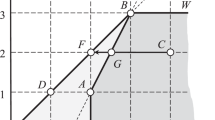Abstract
This paper introduces a computational efficient form to find the optimal solution of technology selection model. The paper suggests an efficient and simple method to obtain the optimal solution of linear programming (LP) problem used in technology selection without the need for solving any LP. Clearly, the contribution of this study is that it improves further the computational complexity of the literature, which is significant when dealing with complexity.
Similar content being viewed by others
References
Karsak EE, Ahiska SS (2005) Practical common weight multi-criteria decision-making approach with an improved discriminating power for technology selection. Int J Prod Res 43(8):1537–1554. doi:10.1080/13528160412331326478
Amin GR, Toloo M, Sohrabi B (2006) An improved MCDM DEA model for technology selection. Int J Prod Res 44(13):2681–2686. doi:10.1080/00207540500472754
Booth DE, Khouja M, Hu M (1992) A robust multivariate statistical procedure for evaluation and selection of industrial robots. Int J Oper Prod Manage 12:15–24. doi:10.1108/01443579210009023
Khouja M (1995) The use of data envelopment analysis for technology selection. Comput Ind Eng 28:123–132. doi:10.1016/0360-8352(94)00032-I
Braglia M, Petroni A (1999) Evaluating and selecting investments in industrial robots. Int J Prod Res 37:4157–4178. doi:10.1080/002075499189718
Charnes A, Cooper WW, Rhodes E (1978) Measuring the efficiency of decision making units. Eur J Oper Res 2(6):429–444. doi:10.1016/0377-2217(78)90138-8
Cooper WW, Seiford LM, Tone K (2006) Introduction to data envelopment analysis and its uses with DEA-solver software and references. Springer, New York
Emrouznejad A, Tavares G, Parker B (2008) A bibliography of data envelopment analysis (1978–2003). Socio Eco Plan Sci doi:10.1016/j.seps.2007. 07.002
Dulá JH (2008) A computational study of DEA with massive data sets. Comput Oper Res 35:1191–1203. doi:10.1016/j.cor.2006.07.011
Barr RS, Durchholz ML (1997) Parallel and hierarchical decomposition approaches for solving large-scale data envelopment analysis models. Ann Oper Res 73:339–372. doi:10.1023/A:1018941531019
Amin GR, Toloo M (2004) A polynomial-time algorithm for finding epsilon in DEA models. Comput Oper Res 31:803–805. doi:10.1016/S0305-0548(03)00072-8
Talluri S, Yoon KP (2000) A cone-ratio DEA approach for AMT justification. Int J Prod Econ 66:119–129. doi:10.1016/S0925-5273(99)00123-1
Sun S (2002) Assessing computer numerical control machines using data envelopment analysis. Int J Prod Res 40:2011–2039. doi:10.1080/00207540210123634
Farzipoor SR (2008) Technology selection in the presence of imprecise data, weight restrictions, and nondiscretionary factors. Int J Adv Manuf Technol doi:10.1007/s00170-008-1514-5
Cook WD, Kress M, Seiford LM (1996) Data envelopment analysis in the presence of both quantitative and qualitative factors. J Oper Res Soc 47:945–953
Author information
Authors and Affiliations
Corresponding author
Rights and permissions
About this article
Cite this article
Amin, G.R. Optimal solution of technology selection model: a computational efficient form. Int J Adv Manuf Technol 43, 1046–1050 (2009). https://doi.org/10.1007/s00170-008-1787-8
Received:
Accepted:
Published:
Issue Date:
DOI: https://doi.org/10.1007/s00170-008-1787-8




